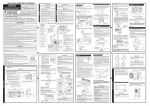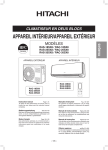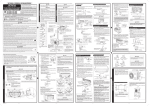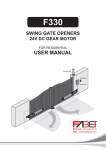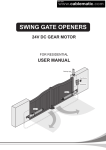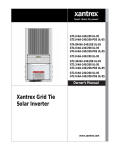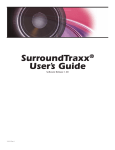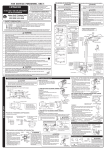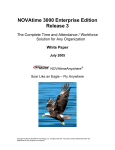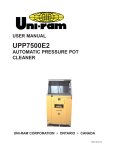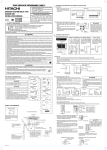Download RAS-18_25_35SX8 Installation Manual
Transcript
Figure showing the installation of Indoor and Outdoor Unit (For example: Ground installation) Mounting board Above 50mm (Above 100mm when there is piping connection at the back of the outdoor unit) 1 Above 50mm 5 Remote controller 3 holder 4 Above 50mm The space indicated by an arrow Û is to guarantee the performance of the air conditioner. Install the apparatus at the ample space in order to carry out the maintenance and repair works. 1 AAA size battery 2 Screw for remote 5 controller holder 2 6 4 Remote controller 6 1 3 Anti-mold wasabi 7 cassette 5 1 Bush Above 50 mm when installed on the ceiling of balcony 2 9 • The difference in height between the indoor and outdoor unit should be kept below 10m. • The connecting pipe, no matter big or small, should all be insulated with insulation pipe and then wrapped with vinyl tape. The insulator will deteriorate if it is not wrapped with tape. Above 50mm 1 Above 200mm Connection of insulated drain hose Please use insulated drain hose Inner diameter 16mm for the indoor piping (commercial product). Above 100mm 0 Binding band Above 200mm 1 Heating efficiency will be enhanced if the space below the outdoor unit is closed so that no air passes through. (Procure the material locally.) • A circuit breaker must be installed in the house distribution box for the direct connected power supply cables to the outdoor unit. In case of other installations a main switch with a contact gap or more than 3mm has to be installed. Without a circuit breaker, the danger of electric shock exists. • Do not install the unit near a location where there is flammable gas. The outdoor unit may catch fire if flammable gas leaks around it. • Please ensure smooth flow of water when installing the drain hose. Improper installing may wet your furniture. • An IEC approved power cord should be used. Power cord type: NYM. For outdoor unit installation, allow at least 2 sides of space around the unit to ensure ventilation flue. About 1.6m —1— Drain hole 8 Bush Push Above 100mm Drain hole Outer diameter: above 16mm Push 8 Bush 9 Drain pipe 1.2 Wall Penetration and Installation of Protection Pipe 1 Drill a ø65mm hole on wall which is slightly tilted towards Indoor WALL Outdoor the outdoor side. Putty Putty 2 Cut the protection pipe according to the wall thickness and pass through the wall hole. 3 Empty gap in the sleeve of Protection Sleeve of protection pipe should be pipe protection completely sealed with putty pipe to avoid dripping of rain water into the room. 2~5mm • There is holes on the base of outdoor unit for condensed water to exhaust. • In order to flow condensed water to the drain, the unit is installed on a stand or a block so that the unit is 100mm above the ground, join the drain pipe as shown in the figure. Cover the other drain holes (2 places) with a bush. To install the bush, put it on the drain hole as shown in the figure and press the both sides of the bush to fit into the hole. • After installation, check whether the drain pipe and bush cling to the base firmly. • Install the outdoor unit horizontally and make sure that condensate drains away. • When using in areas with cold weather Especially when there are heavy snows in areas with cold weather, condensed water may freeze on the base and result in bad drainage. In such areas, please do not install the bush and the drain pipe. Also, make sure that the distance from the drain hole to the ground is 250mm or more. 1. Installation of Mounting Board, Wall Penetration and Installation of Protection Pipe CAUTION • The drain hose can be installed from the left or right of the Indoor unit. When installing the indoor unit, the mounting board must be fixed horizontally or slightly tilted down towards the side of drain hose. If it is tilted above the side of the drain hose, condensed water may overflow. INDOOR UNIT • While placing the mounting board on the wall, embed the board anchor in the wall. • Slide down the mounting plate and then fix the mounting board with the board anchor. Board anchor Level • Protection pipe (commercial product) must be used Be sure that the wire is not in contact with any metal in the wall. Please use the protection pipe as wire passing through the hollow part of the wall to prevent damaged by mouse, possibility of short circuit or fire. • Completely seal with putty High humidity air inside the wall or the outdoor may go in to the room and could result in dripping of dew. It could also cause smell or odor present outdoor and inside the wall spreading into the room. 2.1 Preparation of Installation Changing of drain hose (Horizontally piping) • To remove front panel, please refer to “Removing and • Install and change the drain hose and drain cap when installing Attaching the Front Panel” on page 13. the pipe horizontally as shown below. • Make sure to use both hands to attach and remove the front • Remove the lower cover when installing and changing. panel. • Do not carry out horizontal piping for drain hose. Remove the lower cover • Push the bottom inner part (1) of the lower cover to remove the lower cover. 1 Remove Line Weight Hole for pipe • To attach the lower cover, attach 2 first and then attach 1 by rotating it around 2 as the fulcrum. 1 Remove the screw and pull out the drain hose. Drain hose ø65mm 42.5mm 268mm ø80mm Drain hose • While installing the pipe from the right, left or bottom side, use a knife to cut lower cover bush accordingly. • Use the groove on the outer side if the pipe which is to be installed from the left side, etc. is big. 24mm 36~41mm 1 Remove the auxiliary Projection Cushion insulation material sheet of the which is attached to the indoor unit Fixing pipe insulation. (Keep tab the removed auxiliary insulation material sheet About 15cm because it will be reused after pipe connection.) 2 Hang the indoor unit on the mounting board. 3 Place the cushion under the right rear surface of the indoor unit to lift the lower side of the unit by approximately 15cm. 4 Connect the refrigerating pipe. (Refer to “Pipe Connection” on page 9) 5 Cover the pipe connection with the auxiliary insulation sheet which was removed earlier, with its split line on the top. Wrap the tape without any gap. (Refer to “Installation after connection of refrigerating pipes (Horizontal piping)” on page 5, step 3) 6 Insert the drain hose into the wall hole. 7 Connect the connecting cord. (Refer to “Connection of Power Cord” on page 10). 8 Form connecting cord and refrigerating pipe and put them in the space on the lower side of the rear surface of the indoor unit. 9 Remove the temporary stand and hook the projection on the lower part of the Indoor unit onto the mounting board. Bush part Groove on the Bush part outer side Groove on the inner side Drain cap Push the drain hose deeply into the screw hole, fix with the removed screw during step 1. • Be sure to insert drain hose and drain cap firmly and fix with screw Insufficient insert may result in water leakage. —4— 5 Form the connecting cord and refrigerating pipe and put them in the space on the lower side of the rear surface of the indoor unit. Put the binding band 0 on the hook located on the rear surface to fix it. 6 Join refrigerating pipe, connecting cord and drain hose temporarily with tape and wrap the wall hole portion with tape. 1 Insert the pipes through the wall hole. 2 Hang the upper part of the Indoor unit on the mounting board. 3 Push the lower part of the indoor unit to the wall, hook the projection on the lower part of the Indoor unit onto the mounting board. 4 Cover the pipe connection with the auxiliary insulation sheet which was removed earlier, with its split line on the top. Wrap the tape without any gap. (Refer to “Heat insulation and Finishing of Piping” on page 11) If there is gap or over-tightened, it may cause condensation. 1 1 Mounting board Refrigerating pipe 0 Binding band Protection pipe Binding band can be installed to whichever side of the installation points. However, it is recommended to attach it on the right side viewing from the rear. Hook Drain hose Pipe Connecting cord 2 Wrap with tape 1 Mounting board Be sure to cut the extra binding band. (Otherwise, it may result in abnormal noise or dewfall.) Projection of the indoor unit 3 How to remove the indoor unit • Push the [PUSH] section at the bottom of the indoor unit from the outside, the claws are released from the mounting board. (2 places on the left and right) • If the bottom of the indoor unit cannot be pushed, remove the bottom part of the front cover and insert a screwdriver into the hole for removal of indoor unit as shown in the figure. Then, push the claws upwards while holding down the upper part of the hole 1 and pull the indoor unit towards you 2. When horizontal piping is used, be careful not to damage the pipe and connecting cord with the tip of the screwdriver during this operation. • Please refer to “Removing and Attaching the Front Cover” on page 14 to remove the bottom part of the front cover. CAUTION Hold with hand CAUTION Ditch You are free to choose the side (left or right) for the installation of drain hose. Please ensure the smooth flow of condensed water of the indoor unit during installation. (Careless may result in water leakage.) Condensed water pond • Please mount the outdoor unit on stable ground to prevent vibration and increase of noise level. • Decide the location for piping after sorting out the different types of pipe available. • When removing side cover, please pull the handle after undoing the hook by pulling it downward. Reinstall the side cover in reverse order of the removal. Mounting board 1 Be sure that the drain hose is loosely connected bend or proper condition like left figure. Condensed water pond Bending upwards Hole for removal Please face this side (suction side) of the unit to the wall. Please remove side cover when connecting the piping and connecting cord. Claw Pull downward 2 3. Drainage Check After the indoor unit is installed, please ensure the smooth flow of condensed water of the indoor unit during installation. (Careless work may result in water leakage.) Pull this to the front during Connection part the connection of refrigerating pipe to ease task. Connecting cord Refrigerating pipe 2 Insert drain cap up to the location securely till the cap stops. ø65mm Connecting the refrigerating pipe other than at the back of the indoor unit —6— Screwdriver Drain hose screw CAUTION —3— Auxiliary insulation sheet Wrap with tape Auxiliary insulation sheet Cutting lower cover bush (Horizontal and downward piping) 100 mm 600mm About 90mm Temporarily wrap with tape Split line of the auxiliary insulation sheet must be positioned within this range. Auxiliary insulation sheet Drain hose screw Attach 2.2 Installation Refrigerating pipe Refrigerating pipe Refrigerating pipe insulation sheet 4 Wrap the wall hole portion with tape. Drain hose 1 42mm 200mm 50mm 295mm 20mm Drain hose Refrigerating pipe Cut Auxiliary insulation sheet Protection pipe 2 450mm 95mm 42.5mm Place the refrigerating pipe bending within the wall hole range Use the plier to pull and turn the drain cap for easy removal. Screw at the positions near the upper and lower hooks where the indoor unit is hung. Use more than 4 screws for fixing. 81.5mm Refrigerating pipe insulation sheet • When using a polyester core, make sure to insert it only after flaring is carried out to avoid cutting dust from getting inside. Drain hose Refrigerating pipe CAUTION Drain hose Drain hose 348mm 635mm < S842 : A > ø65 wall hole range Hole for removal Drain cap 158mm 174mm 1 Remove the auxiliary insulation material sheet which is attached to the pipe insulation. Connect the refrigerating pipe. (Refer to “Pipe Connection” on page 9) 2 Cut the heat insulation sheet refrigerating pipe aligning to the insulation sheet of the pipe and fix them temporarily with tape. 3 Cover the pipe connection with the auxiliary insulation sheet which was removed earlier, with its split line on the top. Wrap the tape without any gap. Tape must not be over tightened. (Refer to “Heat insulation and Finishing of Piping” on page 11) If there is gap or over-tightened, it may cause condensation. Refrigerating pipe Connecting the refrigerating pipe at the back of the indoor unit WARNING 2 Screw for mounting board Mounting board Mark Installation after connection of refrigerating pipes (Horizontal piping) Center line of wall hole • Please refer to “Connection of Power Cord” on page 10. 798mm 480mm 450mm 81.5mm ø65mm Drain hose Please bend at a small radius to form an arc. (Pipe can be bent with a small radius without being crushed if polyester core is used.) Center line of wall hole —5— Wiring connection External dimension of indoor unit Connecting cord Piping configuration may be in six different directions: direct rear piping, left or right downward piping and left or right sideways piping. Do not modify the power cable. Remove the front panel Pipe support Horizontally backward 2. Installation of the Indoor Unit Drill Hole for Board Anchor Pipe ø65 wall hole range Transform after bending downward Pipe support —2— Condensed Water Disposal of Outdoor Unit 1.1 Direct Mounting On The Wall • Please use hidden beams in the wall to hold the mounting board. • When it is difficult to look for a stud, use an item such as board anchor (commercial product). • When using the mounting hole provided by the apartment, cut it in such manner that the dimension of the mounting anchor projecting from the wall is 15mm or below. Place the refrigerating pipe bending within the wall hole range Direction of Piping Length of Power Cable About 0.9m ø65 wall hole range Temporary join the refrigerating pipe, drain hose and connecting cord together with tape. The refrigerating machine oil is easily affected by moisture. Use caution to prevent water from entering the cycle. give clearance as wide as possible Drain pipe 56.5mm The indoor piping should be insulated with the enclosed insulation pipe. Insert polyester core (commercial product) into the large diameter pipe. (2) When forming, bend the refrigerating pipe with the smallest radius. When installing the indoor unit above the curtain rail or curtain box, allow dimensions not affecting the airflow. Above 200mm 8 Auxiliary insulation sheet 1.00m If the starting point of refrigerating pipe bending is projected from the wall hole range or if the bending radius is too large, the indoor unit may be lifted from wall and this may cause poor finishing. • Transform the piping while holding down the lower portion of pipe-support by hand. Refrigerating pipe Drain hose Large diameter Below 5mm CAUTION Center line of wall hole 36mm ∼ 41mm Small diameter Place the starting point of refrigerating pipe bending within the wall hole range. Pipe support 3 Temporary join the refrigerating pipe, drain hose and connecting cord together with tape. Above 80mm Layout of horizontally piping from the right 3 Temporary join the refrigerating pipe, drain hose and connecting cord with tape. Connecting cord CAUTION • Do not over tighten vinyl tape on pipe heat insulation sheet Do not over tighten to avoid loss of heat insulating effect and dew condensation. • Pull the lower part of the indoor unit towards you and confirm that the tab of the indoor unit is fit in the installation plate If the tab is not fitted in securely, vibration of the indoor unit becomes stronger. CAUTION • During drainage work, install the drain pipe to ensure smooth drainage. Make sure to carry out drainage check. Careless work may result in water leakage. • Make sure that there is no problem as shown in the figures on page 8. Such problems may cause clogged drain and could result in water leakage. • Drain hose must be at a slope of at least 1/25. • When inserting the drain hose into the drain pipe for embedded piping, etc., do not cut the drain hose in the middle. This may lead to poorer heat insulating performance of the drain hose and could result in water leakage. • Do not lead the drain hose to a place where corrosive gas (sulfur, ammonia, etc.) is generated such as septic tank. Corrosive gas may flow into the indoor unit through the drain hose, and could result in corrosion on the copper pipe and odor in the room. —7— Fixed leg dimension of outdoor unit (10) Be sure to completely seal any gap with putty. Screw for mounting 2 board Pipe support Match the end of the refrigerating pipes with the locations marked with “4” symbol. Please bend at a small radius to form an arc. Drain hose If the starting point of refrigerating pipe bending is projected from the wall hole range or if the bending radius is too large, the indoor unit may be lifted from wall and this may cause poor finishing. Place the ending point of refrigerating pipe bending within this range. 2 1 Pipe Wall hole range Please bend at a small radius to form an arc. • Form and set the refrigerating pipe and connecting cord. Unit: mm Fixed leg 57 In snowy region, install a snow guard and elevated stand to ensure the airflow for better heating efficiency. In other regions, it is recommended to install a tent for shade. 330 310 1 Bottom cover bush hole Connecting the refrigerating pipe at the back of the indoor unit Forming of refrigerating pipe for horizontally backward piping (1) Refer to the mark at the back, start bending the refrigerating piping within wall hole range. Tent 12 10 Qty 1 Remove the auxiliary insulation material sheet which is attached to the pipe insulation. (Keep the removed auxiliary insulation material sheet because it will be reused after pipe connection.) 2 Carry out refrigerating pipe forming. 4 Form the refrigerating pipe according to the wall hole position. Especially in the case of horizontally backward piping, follow the instruction below to carry out accurate forming. OUTDOOR UNIT Supplied Items Place the starting point of refrigerating pipe bending within the wall hole range. 24mm No. Items 8 & 9 are included in the package of the outdoor unit. CAUTION OUTDOOR UNIT The indoor unit (air outlet) should be installed at least 1.5m away from fire alarm. Must not bend About 0.45m WARNING • Do not expose the unit under direct sunshine or rain. Besides, ventilation must be good and clear of obstruction. • The air blown out of the unit should not point directly to animals or plants. • The clearances of the unit from top, left, right and front are specified as Û in figure below. At least two sides must be clear for ventilation. • Be sure that the hot air blown out of the unit and noise do not disturb the neighbourhood. • Place not exposed to strong wind Particularly on the rooftop of a building, strong wind blows and the outdoor unit may be damaged. • Do not install at a location where there is flammable gas, steam, oil and smoke. • The location must be convenient for water drainage. • Place the outdoor unit and its connecting cord at least 1m away from the antenna or signal line of television, radio or telephone. This is to avoid noise interference. • Do not install the indoor unit in a place where small animals may build their nests. If small animal goes inside the unit and touches the electrical parts, failure of the unit, smoke or fire may be caused. Request your customer to keep the surrounding of the unit clean. 1 Remove the auxiliary insulation material sheet which is attached to the pipe insulation. 2 Referring to the mark on the rear side, form the pipe within the wall hole range. 36~41mm • Read the safety precautions carefully before operating the unit. • The contents of this section are vital to ensure safety. Please pay special attention to the following sign. WARNING ...... Incorrect methods of installation may cause death or serious injury. Make sure to connect earth line. CAUTION ....... Improper installation may result in serious consequence. This sign indicates prohibition. Be sure that the unit operates in proper condition after installation. Explain to customer the proper operation and maintenance of the unit as described in the user’s guide. Ask customers to keep this installation manual together with the instruction manual. • No nearby heat source and no obstruction near the air outlet is allowed. • The clearance distances from top, right and left are specified as Û in figure below. • The location must be convenient for water drainage and pipe connection with the outdoor unit. • Do not install at a location where there is flammable gas, steam, oil and smoke. There is a risk of fire, explosion, deterioration of resin and/or damage. • To avoid interference from noise, please place the unit and its remote controller at least 1m from the radio and television. • To avoid any error in signal transmission from the remote controller, please put the controller far away from high-frequency machines and high-power wireless systems. • Lighting fixtures with electronic starters may shorten the reception distance and may even interfere with the signal being received. Backward piping 56.5mm SAFETY PRECAUTION • Please request your sales agent or qualified technician to install your unit. Water leakage, short circuit or fire may occur if you do the installation work yourself. • Please observe the installation stated in the installation manual during the process of installation. Improper installation may cause water leakage, electric shock and fire. • Make sure that the units are mounted at locations which are able to provide full support to the weight of the units. If not, the units may collapse and impose danger. • Observe the rules and regulations of the electrical installation and the methods described in the installation manual when dealing with the electrical work. Use cables which are approved official in your country. Be sure to use the specified circuit. A short circuit and fire may occur due to the use of low quality wire or improper work. • Be sure to use the specified cables for connecting the indoor and outdoor units. Please ensure that the connections are tight after the conductors of the wire are inserted into the terminals to prevent the external force is being applied to the connection section of the terminal base. Improper insertion and loose contact may cause over-heating and fire. • Please use the specified components for installation work. Otherwise, the unit may collapse or water leakage, electric shock, fire or stronger vibration may occur. • Be sure to use the specified piping set for R410A. Otherwise, this may result in broken copper pipes or faults. • When installing or transferring an air conditioner to another location, make sure that air other than the specified refrigerant (R410A) does not enter the refrigeration cycle. If other air should enter, the pressure level of the refrigeration cycle may increase abnormally which could result in a rupture and injury. • Be sure to ventilate fully if a refrigerant gas leak while at work. If the refrigerant gas comes into contact with fire, a poisonous gas may occur. • After completion of installation work, check to make sure that there is no refrigeration gas leakage. If the refrigerant gas leaks into the room, coming into contact with fire in the fan-driven heater, space heater, etc., a poisonous gas may occur. • Unauthorized modifications to the air conditioner may be dangerous. If a breakdown occurs please call a qualified air conditioner technician or electrician. Improper repairs may result in water leakage, electric shock and fire, etc. • Be sure to connect the earth line from the power supply wire to the outdoor unit and between the outdoor and indoor unit. Do not connect the earth line to the gas tube, water pipe, lighting rod or the earth line of the telephone unit. Improper earthing may cause electric shocks. • When finishing the refrigerant collection (pumping down), stop the compressor and then remove the coolant pipe. If you remove the refrigerant pipe while the compressor is operating and the service valve is released, air is sucked and a pressure in the freezing cycle system will build up steeply, causing an explosion or injury. • When installing the unit, be sure to install the refrigerant pipe before starting the compressor. If the refrigerant pipe is not installed and the compressor is operated with the service valve released, air is sucked and the pressure level of the refrigeration cycle may increase abnormally which could result in a rupture and injury. CAUTION Maximum pipe length 20m • Be sure to perform the cleaning unit operation check. • Unlike conventional types, this model has no grille on its top surface. INDOOR UNIT RAS-18SX8 / RAC-18SX8 RAS-25SX8 / RAC-25SX8 RAS-35SX8 / RAC-35SX8 • The outdoor unit must be mounted at a location which can support heavy weight. Otherwise, noise and vibration will increase. CAUTION Horizontally and downward piping from the right Preparation of Pipe WARNING • The unit should be mounted at stable, non-vibratory location which can provide full support to the unit. Tools Needed For Installation Work ( mark is tool exclusive use for R410A) • ª · Screwdriver • Measuring Tape • Knife • Saw • Pipe Cutter • Hexagonal Wrench Key ( 4mm) • Power Drill (ø65~ø80mm) • Vacuum Pump • Pliers or Wrench • Torque Wrench Vacuum Pump Adaptor Flare Tool Gas Leakage Detector Manifold Valve Charge Hose (Please note the following matters and obtain permission from customer before installation.) WARNING • Carefully read through the procedures of proper installation before starting installation work. • The sales agent should inform customers regarding the correct operation of installation. HITACHI SPLIT UNIT AIR CONDITIONER INSTALLATION MANUAL INDOOR UNIT / OUTDOOR UNIT Installation information THE CHOICE OF MOUNTING SITE About 300mm FOR SERVICE PERSONNEL ONLY 500 39 125 CAUTION • Do not touch the suction port, bottom surface or aluminium fin of the outdoor unit Failure to do so may cause an injury. Elevated stand —8— 2. Pipe Connection • Use a pipe cutter to cut the pipe and remove burr. • Remove the flare nut from the pipe of the indoor unit by removing the flare nut (female side) with a spanner while holding down the half union (male side) with a spanner. • Do not crush the pipe while bending it. • Apply refrigerant oil on the connection part. After carrying out the center alignment and manual tightening of the flare nut, tighten the flare nut securely with a torque wrench (spanner). Trimming tool Copper pipe • Remove burr If burr is not removed, it may cause leakage. • Point the side to be trimmed downwards during trimming to prevent copper chips from entering the pipe. Male side Die Wrench Torque wrench Procedures of Wiring A Detail of Cutting the Connecting Cord * Tightening torque must be as shown in the table below. Copper pipe Outer diameter of pipe (ø) Torque N•m (kgf•cm) Small diameter side 6.35 (1/4 ”) 13.7~18.6 (140~190) Large diameter side 9.52 (3/8 ”) 34.3~44.1 (350~450) Valve head cap Small diameter side 6.35 (1/4 ”) 19.6~24.5 (200~250) Large diameter side 9.52 (3/8 ”) 19.6~24.5 (200~250) Please use exclusive tool for refrigerant R410. A (mm) Rigid Flaring Tool For R410A tool For R22 tool 6.35 (1/4 ”) 0~0.5 1.0 9.52 (3/8 ”) 0~0.5 1.0 Valve core cap • When removing flare nut of the indoor unit, first remove the nut of small diameter side. Otherwise the nut of big diameter side will fly out. • Prevent water from entering into the piping when connecting. • Be sure to tighten the flare nut to the specified torque with a torque wrench. If the flare nut is overtightened, it may split after sometime and may cause refrigerant leak. • When using a control valve, make sure that the packing is not deteriorated and avoid excessive tightening of the handle. Otherwise, gas may leak from the service valve. 3. Remove of Air from the Pipe and Gas Leakage Inspection • Fully tighten the “Hi” shuttle of the manifold valve and completely unscrew the “Lo” shuttle. Run the vacuum pump. (Adapter is switched on) • After pumping for about 10-15 minutes, completely tighten the “Lo” shuttle and switch off the vacuum pump. (Adapter is switched off) 2 Meter showing pressure Make sure the meter reaches -0.1MPa Closed (-76cmHg) during pumping. 1 3 R410A Manifold valve When pumping starts, slightly loosen the flare nut to check if air sucked in. Then tighten the flare nut. Valve Vacuum pump Ball valve 4 Charge hose Vacuum pump adapter Please leave the ball valve fully open at all times. Ball valve • Indoor unit Indoor unit • Remove the valve head cap of the service valve. • Remove the cap of valve core and connect the charge hose. • Connect the vacuum pump adapter to the vacuum pump and connect the charge hose to the adapter. Valve head cap for the service valve at small diameter side Valve head cap for the service valve at large diameter side Cap of valve core • Loosen the spindle of the service valve with small diameter by 1/4 turn and tighten the spindle immediately after 5 to 6 seconds. • Remove the charging hose from the service valve. • Unscrew the spindle of both the service valves in anticlockwise direction to allow the flow of refrigerant (unscrew halfway). • Tighten the cap of valve head. Check and make sure that there is no gas leakage. Strip wires A B C A B C Connecting cord • Outdoor unit 160mm 10mm 70mm 10mm Strip C, (ground) wires 10mm Connecting cord Connecting cord 45mm 160mm C, (ground) 10mm A, B Strip wires Green + Yellow 20mm 100mm WARNING • The naked part of the wire core should be 10mm fix it to the terminal tightly. Then try to pull the individual wire to check if the contact is tight. Improper insertion may burn the terminal. • Be sure to use only wire specified for the use of air-conditioner. • Please refer to the manual for wire connection, the wiring technique should meet the standard of the electrical installation. • Leave some space in the connecting cord for maintenance purpose and be sure to secure it with the cord band. • Secure the connecting cord along the coated part of the wire using the cord band. Do not exert pressure on the wire as this may cause overheating or fire. Wiring of the Indoor Unit 1 Remove the front panel. (Refer to “Removing and Attaching the Front Panel” on page 13) 2 Remove the terminal cover and screw, hold the upper part when removing. 4 Bring the connecting cord from the rear surface to the front surface through the cable guide. Refrigerating pipe Please refer to the operation manual on how to open and close the front panel. CAUTION • Please do not use excessive force to open and close the movable panel by hands. This may cause malfunction. (The movable panel automatically open and close when the power is ON/OFF and START/STOP.) Screw 3 Remove the lower cover. Connecting cord IMPORTANT Fuse Capacity Cord band 16A time delay fuse Auxiliary insulation sheet A Drain hose Do not cut the drain hose in the middle B • Install the 7 anti-mold wasabi cassette. (Refer to page 8 of the Operation Manual) Noise may occur if the anti-mold wasabi cassette is not installed properly. • Do not remove the remote controller by twisting it left and right. Doing so could result in coming off of the rear cover. 7 Anti-mold wasabi cassette 4 Remove the bottom part of the front cover by pulling it forward. 5 Hold onto the left side of the front cover and remove while pulling in the direction of the arrow. 3 Tighten the screws on the terminal cover and on the left and right sides of the front cover. 4 Tighten the screws at the bottom of the front cover and replace the screw cover. Screw 6 Insert the screwdriver into the hole on the upper right of the front cover to release the tab. Attaching Arm 5 Attach the front panel. 7 Hold onto the right side of the front cover and remove while pulling in the direction of the arrow. — 14 — How to check Micro Mesh Stainless Filter installation CAUTION This is utilized to avoid the interference of remote controller signals when two indoor units are installed in the same room. The Address Selector Switch is on the outside of the remote controller battery cover. (Factory setting is set to “A”) • Setting the address (to avoid interference) Only one of the two indoor units has to be set (turn off the power to the other indoor unit). 1 Place a battery in the remote controller and press the reset switch. (Refer to page 11 of the Operation Manual) 2 While pointing the remote controller transmitter/receiver at the indoor unit, move the switch of the Address Selector Switch to “B”. 3 The channel is set when the unit beeps, confirming it has received the signal. • After changing the address, please confirm the unit’s operation with the remote controller. If the unit does not operate, return the switch to “A” and set the switch again. • Once the installation work has been completed, close the front panel and insert the power plug into the power outlet, and then carry out “Filter Cleaning Operation Check”. Address Filter Cleaning Operation Check Address Installing the Micro Mesh Stainless Filters After the installation work has been completed, be sure to carry out “Filter Cleaning Operation Check” before performing trial run (cooling or heating)! Switch • Remove the front panel and check if the filter locks (4 pcs) are tripped or slant. • If the filters are not inserted properly, refer to following “Installing the Micro Mesh Stainless Filters”. • Please perform “Filter cleaning operation check” again after reinstalled the filters. • Slide the locks (2 places each on the left and right) of the micro mesh stainless filters upwards. Address selector switch • Align the filter with the top face of the indoor unit, and then slide and push it in. (The shape of the left and right filters are the same.) Lock (1) Before turning on the power of the air conditioner, make sure that the filters (2 pieces at the top and 2 pieces in front) have been installed properly and locked. (2) When the power of the air conditioner turns on, the “Filter Cleaning Operation” starts automatically. The clean indicator is lit during the filter cleaning operation. 3. Remove the Protection Sheet • Remove the protection sheet on the display panel. Do not touch the cleaning unit during the filter cleaning operation. Doing so could result in injury or failure of the appliance. Unlike the coventional type of air conditioner, this air conditioner has no grille at its top surface, It is because this air conditioner is equipped with the cleaning unit, and to prevent the top surface from getting dirty easily. Cleaning Unit Display panel 4. Power Source and Operation Test Force-cooling operation Power source WARNING • Never modify or extend the power cord. • Keep additional length for the power cord and do not render the plug under external force as this may cause poor contact. • Do not fix the power cord with U-shape nail. • The power cable easily generates heat. Do not bring the cable together with a wire or vinyl tie. • When the temporary switch of the indoor unit is pressed for more than 5 seconds, the force-cooling operation starts. Use this mode when performing the failure diagnosis or collecting refrigerant into the outdoor unit. • The Timer lamp flashes when force-cooling is in operation. • Press the temporary switch again or use the remote controller to stop the force-cooling operation once this operation is completed. CAUTION • Use a new power outlet. Old power outlet may cause insufficient electrical contact, which could result in unforeseen accident. • Connect and disconnect the power plug a few times to ensure smooth plug-in before completely insert the power plug into the power outlet. Temporary switch (Force-cooling operation starts when the switch is pressed for more than 5 seconds. Press the switch again and use the remote controller to stop the operation.) CAUTION Operation test Prohibited — 11 — 1 Push the end of the right-side arm outward to release the tab. 2 Move the left-side arm outward to release the left tab, and then pull the panel towards you. C Putty • Completely seal any gap with putty High humidity air inside the wall or the outdoor may go in to the room and could result in dripping of dew. It could also cause smell or odor present outdoor and inside the wall spreading into the room. Right side of the front cover — 13 — Putty CAUTION Screw Screw Cord band About 90mm When using an exit cover, do not attach a bush for pipe. Bottom part of the front cover 1 Insert the shaft of the left arm along the step on the unit into the hole. 2 Securely insert the shaft of the right arm along the step on the unit into the hole. 3 Make sure that the front panel is securely attached, and then close the front panel. Bush for pipe • The remote controller may be affixed to a wall or pillar with the remote controller mounting screw. • When operating the air conditioning with the remote controller attached, please make sure that the signal is received by the air conditioning. Furthermore, fluorescent lighting may affect the reception of the signal, therefore, please make sure by turning on the fluorescent lighting even during the day. • Lighting fixtures with electronic starters may shorten the reception distance and may even interfere with the signal being received. < S842 : A > Arm Connecting cord Refrigerating pipe 2. Affixing the Remote Controller and Installing the Anti-mold Wasabi Cassette • Hold the upper part of the remote controller to pull it out. Arm Screw Step • Please ensure that the air conditioner is in normal operating condition during the operation test. • Explain to your customer about the proper operation procedures as described in the operation manual. • If the indoor unit won’t operate, check the cable for correct connection. • Do not operate the unit for more than 5 minutes while the spindle of the service valve is closed. OPERATION CHECK FINAL STAGE Insulate and wrap with tape Seal with putty Connecting cord Left side of the front cover Drain hose 1. Heat Insulation and Finishing of Piping • Insert from above. Push 2 About Address Selector Switch Terminal cover Earth terminal WARNING Wall or pillar 3 Remote controller holder 1 Step 5 Connect the connecting cord and fix with cord band. 6 Hook onto the claw at the lower part of the terminal cover and fix with screw. Hexagonal wrench key Please remove the side cover and terminal cover for wiring connection. 5 Screw for remote controller holder Terminal cover Removing — 10 — Installation Fix on the top tabs (2 places) Movable panel Cable guide Terminal cover Cap of valve core Terminal marking ABC • Cover the pipe connection with the auxiliary insulation sheet, wrap the tape without any gap. • If there is gap or over-tightened, it may cause condensation. • Please wrap the pipe and power cord together with vinyl tape as shown in the figure of the installation of indoor and outdoor units on page 2. • To enhance the heat insulation and to prevent water condensation, please cover the outdoor part of the drain hose and pipe with insulation sheet. • When using an exit cover, do not attach a bush for pipe. • When an exit cover is not used, seal the gap of the hole on the wall, bush and pipe completely with putty. If an exit cover is used, seal the gap of the hole on the wall and pipe completely with putty. In the case of embedded piping, seal the gap of the pipe completely with putty. Incomplete sealing could cause entering of high humidity air into the wall or indoor unit, which could result in dripping of dew. It could also cause smell or odor present outdoor and inside the wall spreading into the room. 1 Make sure that the dew receiving pan and the cleaning unit are securely attached. 2 After attaching the left and right sides of the front cover onto the unit, ensure that the top tabs (2 places) have been fix on. Screw Cap of valve head Wiring of the Outdoor Unit 1 Remove the front panel. 2 Remove the screw cover at the bottom of the front cover and remove the screw. 3 Remove the screws on the terminal cover, on the left side of the front cover and the screw on the right side. Arm Body of service valve Cap of valve head Green + Yellow (ground) A, B ø2.0 —9— • The connecting cord must be fix with cord band Otherwise rain water may enter and causes short circuit. Besides, an external force may apply to the connection part of the connecting cord and could result in heat and fire. • The terminal cover must be installed after work is done. 70mm 10mm Outdoor unit AC 220-230 1ø 50Hz 12.3~15.7 (125~160) CAUTION From the viewpoint of global environment protection, air purge type should be vacuum pump method. • Be sure to hold the front panel with both hands to detach and attach it. Female side Die Outer Diameter (ø) Attaching the Front Cover Removing the Front Cover Removing and Attaching the Front Panel From the viewpoint of global environment protection, refrigerant should be recovered (pumped down) when the air conditioner is transferred or removed. 1 Perform force-cooling operation (refer to “Force-cooling operation” on page 12) for about 5 minutes as a preliminary operation. 2 Tighten the spindle of the service valve at small diameter side in clockwise direction. 3 Continue the force-cooling operation for another 1-2 minutes, and then tighten the spindle of the service valve at large diameter side in clockwise direction. 4 Stop the force-cooling operation. Flare nut Half union • Before flaring, please put on the flare nut. Please use gas leakage detector to check if leakage occurs at connection of Flare nut as shown on the right. If gas leakage occurs, further tighten the connection to stop leakage. (Be sure to use R410A detector.) CONNECTION OF POWER CORD INSTALLATION OF REFRIGERATING PIPES AND AIR REMOVAL CAUTION Works to be done when transferring or removing air conditioner Gas Leakage Inspection REMOVING AND ATTACHING THE FRONT COVER 1. Pipe Cutting and Flaring • Place the micro mesh stainless filter with its side having indication of UPPER FILTER and BACK facing towards the unit. (The shape of the left and right filters are the same.) • Insert the bottom side of micro mesh stainless filter (left and right), then slightly bend and insert it in the arrow direction. Bend and insert • Push up the filter lock (both side) on the top surface. Insert all Filter lock Front Panel Filter Lock • Make sure that the top filters have been locked. Lock the filters if they are not locked.(The filters may come off during the operation if they are not locked.) • Close the front panel properly. (The filter cleaning operation does not start if the front panel is not closed properly.) • If the front panel is opened during the operation check, the operation will stop immediately. Clean Indicator H-LINK This indicator is lit during the filter cleaning operation. It blinks if any abnormal condition occurs during the filter cleaning operation. • Filter cleaning operation check will take approximately 7 minutes for the cleaning unit to make one cycle of back and forth movement. Make sure that the cleaning unit is actually working by a visual inspection from the top of the indoor unit. • Close the front panel properly. (The filter cleaning operation does not start if the front panel is not closed properly.) • If the front panel is opened during the operation check, the operation will stop immediately. • If the “ON/OFF” button on the remote control is pressed during the operation check, the operation check is stopped before its completion. Wait until the operation check is completed without pressing any button on the remote controller. • If the filters are not installed properly, “Filter Cleaning Operation” is found abnormal and the clean indicator blinks. The filters may come off during operation if they are not installed properly. [For all optional part, please refer catalog for part number] • Slide micro mesh stainless filter lock (2 places on the left and right) downwards. • If the clean indicator blinks during the “Filter Cleaning Operation” means that the operation is stopped before its completion due to an abnormal condition. In this case, refer to “Check the Operation of the Filter Cleaning Unit” and “Troubleshooting” of the operation manual and take appropriate actions. CN7 Engraved mark UPPER FILTER and BACK at the back. — 12 — — 15 — As for connecting to H-Link, a separately purchased RAC Adapter is required. • To install the wiring, the electrical box cover must be opened. • Connect the connector of RAC Adapter to CN7. • Assemble back the cover of electrical box. • Please refer to the respective user manual of RAC Adapter for further details. • Please be careful not to damage lead wires by edge of plate when connecting the optional parts. • You can refer to this installation manual on how to remove and re-attach the front cover. — 16 — CN7




